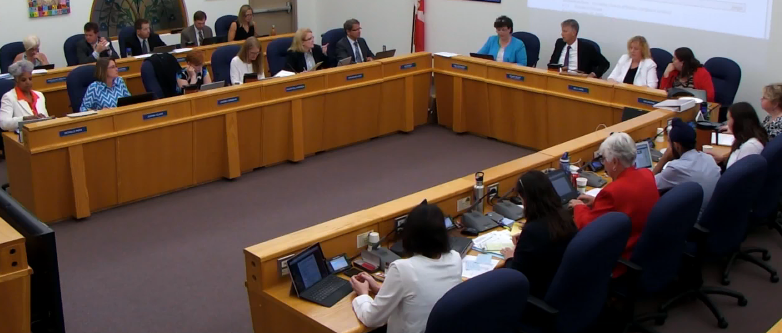 By Graham Fraser
By Graham Fraser
June 14, 2106
BURLINGTON, ON
One of the things I like about this job, that pays me less than nothing, is the responses we get from readers. Elise Box wrote and chided me for what she felt was my giving space to just on side of the French language instruction argument that Halton school board trustees are wrestling with. “I thought since you were in the “pinching,” from the Globe and Mail, you might consider pinching an article that is actually researched based. Perhaps you could assist in sharing the whole picture to the public.” I wouldn’t refer to this as “research based”; it is an opinion from a man I know personally and have a lot of respect for – however it is just an opinion.
For years, I have been listening to the arguments of ill-informed critics of French immersion. The time has come to set the record straight.
Some critics use the percentage of Canadians who are bilingual to argue that French immersion has been a failure. However, percentages are misleading; with Canada welcoming 250,000 newcomers each year, some of whom speak neither official language, it’s not surprising that the percentage of bilingual Canadians has dropped, even though the actual number has increased by more than half a million over the past 10 years.
Others complain that French immersion belongs to a particular chapter of Canadian history. Contrary to what many critics claim, French immersion is not a product of the Trudeau years, but began in the mid-1960s in Quebec, before Pierre Elliott Trudeau was even elected to Parliament. Its goal was to help children acquire language proficiency through the use of French as a language of instruction.
The allegation that it is an elitist program that filters out the children with behavioural problems and special needs is also profoundly unfair. The fact is that when a child in immersion has any kind of learning or behavioural problem, the first response of some schools is to pressure the parents to take their child out of immersion, regardless of whether or not the learning problem has anything to do with the language of instruction. Yet there are studies that show that children with learning problems do just as well in immersion as they do in the English stream.
 Similarly, many schools and school boards actively discourage immigrant parents from enrolling their children in immersion, even though studies show that immigrant students – who often speak a third language at home – adapt smoothly to immersion. Some immersion programs, however, boast a high percentage of children of immigrants, as their parents recognize the value of being able to speak the country’s two official languages.
Similarly, many schools and school boards actively discourage immigrant parents from enrolling their children in immersion, even though studies show that immigrant students – who often speak a third language at home – adapt smoothly to immersion. Some immersion programs, however, boast a high percentage of children of immigrants, as their parents recognize the value of being able to speak the country’s two official languages.
Moreover, critics often refer to the drop-out rate from immersion. This is partly due to students choosing other specialized programs that are not available in immersion, and partly due to other factors. Some 15 years ago, Edmonton Public Schools was concerned about the dropout rate from immersion. By bolstering support for the teachers, improving communication with parents and establishing comparative evaluations of students’ language skills, the dropout rate diminished dramatically. Edmonton Public Schools is now recognized as having one of the best immersion programs in the country.
Some of the disenchantment with immersion comes from unrealistic expectations. Immersion doesn’t – and isn’t intended to – produce graduates who speak French with the fluency of native speakers. What immersion does provide is an important building block on which graduates can develop their language skills. Language proficiency is both an intellectual and a physical activity; without practice, it diminishes dramatically. I hope that the 150th anniversary of Confederation will see an increase in the number of opportunities for students to spend time in an environment where the other official language is dominant.
One of the problems that the immersion system has faced for a number of years has been a shortage of teachers who fully master French. To address this issue, a government program could be useful in breaking down some of the barriers that prevent exchanges between teachers. It is still easier for a teacher in Quebec to have an exchange with a teacher in France than with a teacher in Ontario, and easier for a teacher in Ontario to exchange jobs with a teacher in Australia than with a teacher in Quebec. This, to put it mildly, makes no sense.

Halton District School Board trustees. Senior staff sit in the second row and are on hand to answer questions and provide detail.
The immersion experience can be life-changing. When Jennifer MacIntyre was a child in a small town in Cape Breton, she insisted on going into immersion, overcoming the reluctance of her unilingual parents. Her reason: she wanted to be able to work at Cape Breton’s National Historic Site, the Site Fortress of Louisbourg. The experience broadened her horizons. Now, several decades later, she is Canada’s ambassador to Switzerland. “Without French, nothing else would have been possible and my dreams would have been much smaller,” she told me recently.
Canadian parents – thousands of whom are themselves graduates of immersion – want their children to have the experience that French immersion offers. It has enriched the lives of millions of Canadians. It is unfortunate that an ideal of perfection is being used to criticize one of the most successful Canadian educational experiences available.
Graham Fraser is Canada’s commissioner of official languages.














